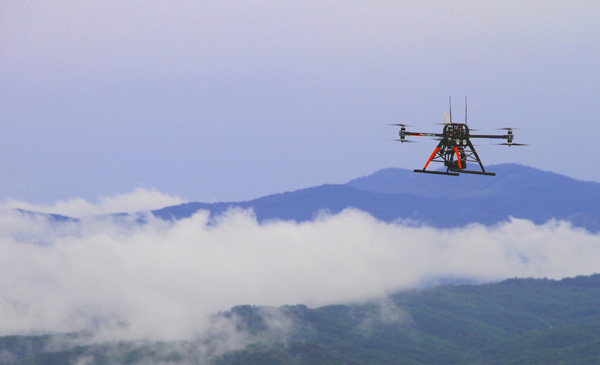Ensure that all steps of the installation and parametrization have been followed as they had to, according to the electronics manufacturer.
Chose a calm and non windy day for your first fly. Do not plan to fly in a too high altitude. This will minimize the chances for damages in case of crash that may occur while you learn to fly the drone. An optimal test flight altitude is between 1,50 to 5 meters of height.
Get familiar with the control in the first test flights. Practice initially starting, taking off, landing and hovering on the spot. Only when you feel safe enough you can start with small flights forwards, backwards and sidewards in order to master the basic maneuvers. Make sure that the front of the drone is always pointed away from the pilot and during the whole flight.
Practice flying without the aid of additional functions like Position Hold, Care Free or Altitude Hold. Only this way you will acquire the skills in order to be able to control the drone even in difficult situations, when the GPS is not operating for instance etc.
Warning: Before the first flight, it is recommended to test the functions (such as turning ON and OFF the motors) without propellers. So you can go along with your transmitter and avoid injuries throughout mishandling.
Make sure that before turning ON the drone all switches on your transmitter are deactivated – OFF.
This ensures that for the first test flight all auxiliary functions such as HoldAltitude, PositionHold and CareFree will be switched OFF.
Place the drone on a sufficiently large and open field. The best way is on a model flight field so that no person, animals or material may be harmed.
First switch the transmitter ON and then the drone, allowing the seconds needed for it to initialize.
Tip: The drone should be standing on the ground while being switched on.
When the initialization process is finished be sure that there are no warnings (audible, visual or both – depending on your electronics).
Wait for the GPS to have acquired a sufficient number of satellites in order to perform a 3D FIX (refer yourself to your electronics user manual for the indication showing this state and that you have to wait for).
Do not take-off without having this GPS 3D FIX, otherwise functionalities like Return to Home will not operate.
Calibration before startup:
Depending on your electronics brand and type, it may be required that you initialize/calibrate the gyros and other sensors before the drone can operate. This process is generally necessary before each flight and after every battery change. If this is not done, the drone will not start.
During that procedure, the aircraft must stand absolutely still.
Starting / Stopping the motors:
| Item | To do |
|---|---|
| 1 | Make sure you have enough space around you to operate the drone safely. |
| 2 | The front of the aircraft must point away from you. |
| 3 | If the Throttle stick is moved upwards, the drone takes off. Here the Throttle stick should be moved gently (not too slow but also not too fast). If the Throttle stick is moved too slowly the drone can keel over to one side during the start. That comes from the, so called, ground effect. If the Throttle stick is moved too fast, the drone can quickly rise to a high altitude. You need to develop the right feeling for the throttle. |
| 4 | When the drone is at a height of around 1,5 to 5 meters, you can enter in the altitude hold process and the Throttle stick can then be hold in the central position (this depends on your Flight-Ctrl board - see your system's details for that). The aircraft should then hover in the same altitude. |
| 5 | If the Throttle-Stick is now moved upwards, the drone continues to rise. If the Throttle-Stick is moved downwards the drone lowers down. |
| 6 | With the Nick and Roll sticks the aircraft can fly forward, backward and also sideways. |
| Item | To do |
|---|---|
| 1 | Make sure that there are no people in the landing zone before touching down with your aircraft. |
| 2 | To land, move the Throttle stick slowly down, while keeping it within the landing area using the Nick and Roll sticks, until the drone touches the ground. |
| 3 | As soon as the aircraft is on the ground, move the Throttle stick completely down. |
| 4 | Turn OFF the motors and disconnect the main battery. |
Warning: Avoid jerky movements on the sticks of the transmitter. This can lead to unexpected strong moves of the drone.
Please continue with the following link “Before each flight”

